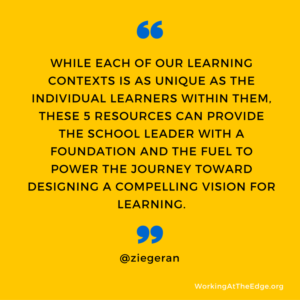 As leaders, we are focused on changing and improving learning in the classroom, but do we know where we are going? Do we have a clear picture of where we want our actions to take us? If asked to share our beliefs about learning, what would we say? How are those beliefs shaped by access to technology and our ability to truly honor the needs and passions of individual learners in the learning process? As leaders, do we anchor our conversations about change in beliefs about learning? Do we lead our teachers, parents, students and communities to understand how investments in human, financial and material resources move us closer to our vision of the ideal learning environment?
As leaders, we are focused on changing and improving learning in the classroom, but do we know where we are going? Do we have a clear picture of where we want our actions to take us? If asked to share our beliefs about learning, what would we say? How are those beliefs shaped by access to technology and our ability to truly honor the needs and passions of individual learners in the learning process? As leaders, do we anchor our conversations about change in beliefs about learning? Do we lead our teachers, parents, students and communities to understand how investments in human, financial and material resources move us closer to our vision of the ideal learning environment?
Over the past school year, work in the Salisbury Township School District has focused on clearly defining outcomes for our graduates and the learning environments to support those outcomes. Through conversations with all representative groups of stakeholders, a Profile of a Graduate (the end-in-mind – knowledge & literacies, skills and dispositions) was developed, and a core set of beliefs about learning and the learning environment were articulated. In essence, the products provide a vision for the future. (We are currently in the process of designing user-friendly visual representations of each document. A future post will explore the process followed to get to these two products and the next stages in our work.)
As I interact with my PLN, engage my colleagues and attend conferences, I often wonder if we have a crisis of vision in education. As organizations, are we too often executing action plans with no clear end in mind? Have we as educators taken the time to explore our beliefs about what our communities want and believe? While these conversations are important, I have learned that if leaders are to address the crisis of vision, they need to build a knowledge base of what is possible – read, engage thought leaders and explore model schools, districts and educational systems doing the real work of changing practice.
The conversations my colleague, Lynn Fuini-Hetten, and I had with stakeholders this year were informed by research on current innovations and thought leadership in progressive education. While many resources formed the basis of our research, here are 5 any leader can start with to begin thinking about vision.
- The End of Average: How we succeed in a world that values sameness by Todd Rose There is no such thing as an average learner. Once we realize this, the door is open for moving our thinking toward true learner-centered environments.
- A Transformational Vision for Education in the US by Education Reimagined This whitepaper digs deeper into the learner centered paradigm and provides a 5-element “north star” for launching conversations to develop a vision for learning. (Listen to our podcast with Kelly Young of Education Reimagined.)
- Freedom to Learn by Will Richardson In addition to exploring how our limitless access to information should change how we think about learning, read about a public school doing the work to completely reimagine learning. (Listen to our podcast with Will Richardson.)
- Make Learning Personal: The What, Who, WOW, Where and Why by Barbara Bray and Kathleen McClaskey The phrase “personalized learning” is batted around, but do we really know what it looks like and how it values learner agency? This resource provides the framework to begin getting comfortable with personalized learning and the accompanying systemic changes. (Listen to our podcast with Barbara Bray.)
- Invent to Learn: Making, Tinkering and Engineering in the Classroom by Sylvia Libow Martinez and Gary Stager Create classroom experiences that align with the natural inclinations of children and the power of learning by doing. (Listen to our podcast with Sylvia Martinez. Listen to our podcast with Gary Stager.)
Approached in the ordered outlined above, the resources take the leader from a broader rationale for reinventing our current system of education to what transformation looks like in the classroom. While each of our learning contexts is as unique as the individual learners within them, these 5 resources can provide the school leader with a foundation and the fuel to power the journey toward designing a compelling vision for learning. Visit TLTalkRadio.org to access interviews from over 30 other thought leaders we interacted with to help define our vision for the future of learning in the Salisbury Township School District.
What are your beliefs about learning?
Connect with Randy on Twitter and on the TLTalkRadio podcast!
Get new content delivered to your inbox and the ebook 3 Key Principles of Digital Transformation. The ebook contains valuable information from my experience leading a digital transformation and working with a variety of stakeholders over the past decade.
- A silver lining - January 22, 2022
- Is our use of tech working against us? 🤔 - September 8, 2021
- What’s NOT going to change in the next 10 years? 🤔 - September 7, 2021
[…] In order to answer these questions, schools need to first have a compelling vision for learning, and it must include high levels of learner agency. You may be interested in an earlier post on our crisis of vision. […]